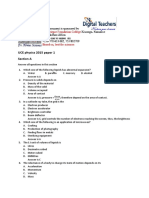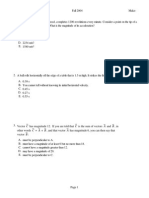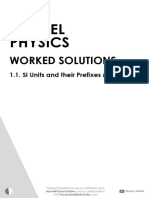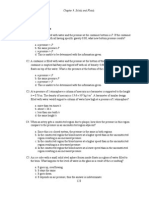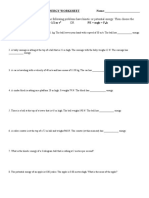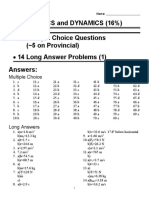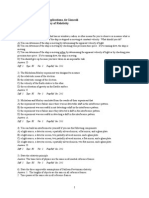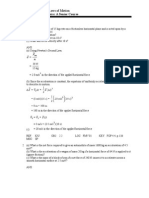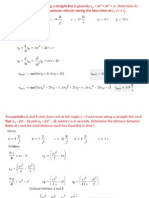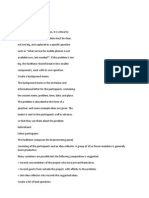100%(1)100% found this document useful (1 vote)
1K viewsPhysics Exit Exam Review
Physics Exit Exam Review
Uploaded by
Cha CastilloThis document contains a 36 question multiple choice physics exam reviewing concepts of kinematics, dynamics, work, energy, momentum, and impulse. The questions involve calculating displacement, average velocity, acceleration, net force, tension, work, power, kinetic energy, momentum, and impulse in various physical situations involving objects moving in one and two dimensions, under constant acceleration, on inclined planes, and colliding with each other.
Copyright:
© All Rights Reserved
Available Formats
Download as PDF, TXT or read online from Scribd
Physics Exit Exam Review
Physics Exit Exam Review
Uploaded by
Cha Castillo100%(1)100% found this document useful (1 vote)
1K views18 pagesThis document contains a 36 question multiple choice physics exam reviewing concepts of kinematics, dynamics, work, energy, momentum, and impulse. The questions involve calculating displacement, average velocity, acceleration, net force, tension, work, power, kinetic energy, momentum, and impulse in various physical situations involving objects moving in one and two dimensions, under constant acceleration, on inclined planes, and colliding with each other.
Original Description:
PHY13
Copyright
© © All Rights Reserved
Available Formats
PDF, TXT or read online from Scribd
Share this document
Did you find this document useful?
Is this content inappropriate?
This document contains a 36 question multiple choice physics exam reviewing concepts of kinematics, dynamics, work, energy, momentum, and impulse. The questions involve calculating displacement, average velocity, acceleration, net force, tension, work, power, kinetic energy, momentum, and impulse in various physical situations involving objects moving in one and two dimensions, under constant acceleration, on inclined planes, and colliding with each other.
Copyright:
© All Rights Reserved
Available Formats
Download as PDF, TXT or read online from Scribd
Download as pdf or txt
100%(1)100% found this document useful (1 vote)
1K views18 pagesPhysics Exit Exam Review
Physics Exit Exam Review
Uploaded by
Cha CastilloThis document contains a 36 question multiple choice physics exam reviewing concepts of kinematics, dynamics, work, energy, momentum, and impulse. The questions involve calculating displacement, average velocity, acceleration, net force, tension, work, power, kinetic energy, momentum, and impulse in various physical situations involving objects moving in one and two dimensions, under constant acceleration, on inclined planes, and colliding with each other.
Copyright:
© All Rights Reserved
Available Formats
Download as PDF, TXT or read online from Scribd
Download as pdf or txt
You are on page 1of 18
!"#$%&$ ()%* ()+, -(.
%(/(- "#$% &
PHYSICS EXIT EXAM REVIEW
Multiple Choice
Identify the letter of the choice that best completes the statement or answers the question.
____ 1. A truck moves 70 m east, then moves 120 m west, and finally moves east again a distance of 90 m. If east is
chosen as the positive direction, what is the truck's resultant displacement?
a. 40 m
b. - 40 m
c. 280 m
d. -280 m
____ 2. An object moves 20 m east in 30 s and then returns to its starting point taking an additional 50 s. If west is
chosen as the positive direction, what is the average speed of the object?
a. 0.50 m/s
b. -0.50 m/s
c. 0.73 m/s
d. 0 m/s
____ 3. A cheetah can run at approximately 100 km/hr and a gazelle at 80.0 km/hr. If both animals are running at full
speed, with the gazelle 70.0 m ahead, how long before the cheetah catches its prey?
a. 12.6 s
b. 25.2 s
c. 6.30 s
d. 10.7 s
____ 4. A cheetah can maintain its maximum speed of 100 km/hr for 30.0 seconds. What minimum distance must a
gazelle running 80.0 km/hr be ahead of the cheetah to escape?
a. 100 m
b. 167 m
c. 70.0 m
d. 83.0 m
____ 5. A railroad train travels forward along a straight track at 80.0 m/s for 1 000 m and then travels at 50.0 m/s for
the next 1 000 m. What is the average velocity?
a. 65.0 m/s
b. 61.5 m/s
c. 63.7 m/s
d. 70.0 m/s
____ 6. A ball is thrown vertically upwards at 19.6 m/s. For its complete trip (up and back down to the starting
position), its average velocity is:
a. 19.6 m/s.
b. 9.80 m/s.
c. 4.90 m/s.
d. 20.1 m/s.
____ 7. A 50-g ball traveling at 25.0 m/s is bounced off a brick wall and rebounds at 22.0 m/s. A high-speed camera
records this event. If the ball is in contact with the wall for 3.50 ms, what is the average acceleration of the
ball during this time interval?
a. 13 400 m/s
2
b. 6 720 m/s
2
c. 857 m/s
2
d. 20 m/s
2
!"#$%&$ ()%* ()+, -(.%(/(- "#$% '
____ 8. A ball is pushed with an initial velocity of 4.0 m/s. The ball rolls down a hill with a constant acceleration of
1.6 m/s
2
. The ball reaches the bottom of the hill in 8.0 s. What is the ball's velocity at the bottom of the hill?
a. 10 m/s
b. 12 m/s
c. 16 m/s
d. 17 m/s
____ 9. A vehicle designed to operate on a drag strip accelerates from zero to 30 m/s while undergoing a straight line
path displacement of 45 m. What is the vehicle's acceleration if its value may be assumed to be constant?
a. 2.0 m/s
2
b. 5.0 m/s
2
c. 10 m/s
2
d. 15 m/s
2
____ 10. A bird, accelerating from rest at a constant rate, experiences a displacement of 28 m in 11 s. What is its
acceleration?
a. 0.21 m/s
2
b. 0.46 m/s
2
c. 0.64 m/s
2
d. 0.78 m/s
2
e. 0.97 m/s
2
____ 11. Two ropes are attached to a 40-kg object. The first rope applies a force of 25 N and the second, 40 N. If the
two ropes are perpendicular to each other, what is the resultant acceleration of the object?
a. 1.2 m/s
2
b. 3.0 m/s
2
c. 5.0 m/ s
2
d. 25 m/s
2
e. 47 m/s
2
____ 12. The acceleration due to gravity on the Moon's surface is one-sixth that on Earth. What net force would be
required to accelerate a 20-kg object at 6.0 m/s
2
on the moon?
a. 1.3 N
b. 20 N
c. 33 N
d. 120 N
e. 130 N
____ 13. A 2 000-kg sailboat experiences an eastward force of 3 000 N by the ocean tide and a wind force against its
sails with magnitude of 6 000 N directed toward the northwest (45 N of W). What is the magnitude of the
resultant acceleration?
a. 2.2 m/s
2
b. 2.1 m/s
2
c. 1.5 m/s
2
d. 3.0 m/s
2
e. 1.2 m/s
2
____ 14. A cart of weight 20 N is accelerated across a level surface at 0.15 m/s
2
. What net force acts on the wagon? (g
= 9.8 m/s
2
)
a. 0.92 N
b. 0.31 N
c. 3.0 N
d. 4.5 N
e. 5.2 N
!"#$%&$ ()%* ()+, -(.%(/(- "#$% (
____ 15. Two blocks, joined by a string, have masses of 6.0 and 9.0 kg. They rest on a frictionless horizontal surface.
A 2nd string, attached only to the 9-kg block, has horizontal force = 30 N applied to it. Both blocks
accelerate. Find the tension in the string between the blocks.
a. 18 N
b. 28 N
c. 12 N
d. 15 N
e. 16 N
____ 16. Two blocks of masses 20 kg and 8 kg are connected together by a light string and rest on a frictionless level
surface. Attached to the 8-kg mass is another light string, which a person uses to pull both blocks
horizontally. If the two-block system accelerates at 0.5 m/s
2
what is the tension in the connecting string
between the blocks?
a. 14 N
b. 6 N
c. 10 N
d. 4.0 N
e. 9.0 N
____ 17. A 10-kg mass and a 2.0-kg mass are connected by a light string over a massless, frictionless pulley. If g = 9.8
m/s
2
, what is the acceleration of the system when released?
a. 2.5 m/s
2
b. 6.5 m/s
2
c. 7.8 m/s
2
d. 9.8 m/s
2
e. 9.9 m/s
2
____ 18. A 20-kg traffic light hangs midway on a cable between two poles 40 meters apart. If the sag in the cable is
0.40 meters, what is the tension in each side of the cable?
a. 12 000 N
b. 9 800 N
c. 4 900 N
d. 3 200 N
e. 980 N
____ 19. Find the tension in an elevator cable if the 1 000-kg elevator is descending with an acceleration of 1.8 m/s
2
,
downward.
a. 5 700 N
b. 8 000 N
c. 9 800 N
d. 11 600 N
e. 12 800 N
____ 20. A 10.0-kg mass is placed on a 25.0
o
incline and friction keeps it from sliding. The coefficient of static friction
in this case is 0.580, and the coefficient of sliding friction is 0.520. What is the frictional force in this
situation?
a. 41.4 N
b. 88.8 N
c. 46.2 N
d. 51.5 N
e. 67.9 N
____ 21. A worker pushes a wheelbarrow with a force of 40 N over a level distance of 6.0 m. If a frictional force of 24
N acts on the wheelbarrow in a direction opposite to that of the worker, what net work is done on the
wheelbarrow?
a. 240 J
!"#$%&$ ()%* ()+, -(.%(/(- "#$% )
b. 216 J
c. 144 J
d. 96 J
e. 75 J
____ 22. A horizontal force of 200 N is applied to a 55-kg cart across a 10-m level surface. If the cart accelerates at 2.0
m/s
2
, then what is the work done by the force of friction as it acts to retard the motion of the cart?
a. -1 100 J
b. -900 J
c. -800 J
d. -700 J
e. -600 J
____ 23. A 1 200-kg automobile moving at 25 m/s has the brakes applied with a deceleration of 8.0 m/s
2
. How far does
the car travel before it stops?
a. 39 m
b. 47 m
c. 55 m
d. 63 m
e. 72 m
____ 24. A 7.00-kg bowling ball falls from a 2.00-m shelf. Just before hitting the floor, what will be its kinetic energy?
(g = 9.80 m/s
2
and assume air resistance is negligible)
a. 14.0 J
b. 19.6 J
c. 29.4 J
d. 137 J
e. 156 J
____ 25. A professional skier reaches a speed of 56 m/s on a 30 ski slope. Ignoring friction, what was the minimum
distance along the slope the skier would have had to travel, starting from rest?
a. 110 m
b. 160 m
c. 320 m
d. 640 m
e. 720 m
____ 26. A 15.0-kg crate, initially at rest, slides down a ramp 2.0 m long and inclined at an angle of 20 with the
horizontal. If there is no friction between ramp surface and crate, what is the kinetic energy of the crate at the
bottom of the ramp? (g = 9.8 m/s
2
)
a. 220 J
b. 690 J
c. 10 J
d. 100 J
e. 140 J
____ 27. I drop a 60-g golf ball from 2.0 m high. It rebounds to 1.5 m. How much energy is lost?
a. 0.29 J
b. 0.50 J
c. 0.88 J
d. 1.0 J
e. 1.1 J
____ 28. A 60-kg woman runs up a flight of stairs having a rise of 4.0 m in a time of 4.2 s. What average power did she
supply?
a. 380 W
!"#$%&$ ()%* ()+, -(.%(/(- "#$% *
b. 560 W
c. 620 W
d. 670 W
e. 730 W
____ 29. An automobile delivers 30.0 hp to its wheels when moving at a constant speed of 22.0 m/s. What is the
resistance force on the automobile at this speed? (1 hp = 746 watts)
a. 18 600 N
b. 410 000 N
c. 1 020 N
d. 848 N
e. 763 N
____ 30. The net force acting on a 6.0-kg object is given by F
x
= (10 - x) N, where F
x
is in newtons and x is in meters.
How much work is done on the object as it moves from x = 0 to x = 10 m?
a. 100 J
b. 75 J
c. 50 J
d. 25 J
____ 31. A 0.12-kg ball is moving at 6 m/s when it is hit by a bat, causing it to reverse direction and have a speed of 14
m/s. What is the change in the magnitude of the momentum of the ball?
a. 0.39 kg!m/s
b. 0.42 kg!m/s
c. 1.3 kg!m/s
d. 2.4 kg!m/s
e. 3.2 kg!m/s
____ 32. Alex throws a 0.15-kg rubber ball down onto the floor. The ball's speed just before impact is 6.5 m/s, and just
after is 3.5 m/s. What is the change in the magnitude of the ball's momentum?
a. 0.09 kg!m/s
b. 1.5 kg!m/s
c. 4.3 kg!m/s
d. 5.7 kg!m/s
____ 33. Lonnie pitches a baseball of mass 0.20 kg. The ball arrives at home plate with a speed of 40 m/s and is batted
straight back to Lonnie with a return speed of 60 m/s. If the bat is in contact with the ball for 0.050 s, what is
the impulse experienced by the ball?
a. 360 N!s
b. 20 N!s
c. 400 N!s
d. 9.0 N!s
____ 34. Ann the Astronaut weighs 60 kg. She is space walking outside the space shuttle and pushes a 350-kg satellite
away from the shuttle at 0.90 m/s. What speed does this give Ann as she moves toward the shuttle?
a. 4.0 m/s
b. 5.3 m/s
c. 8.5 m/s
d. 9.0 m/s
____ 35. A 2 500-kg truck moving at 10.00 m/s strikes a car waiting at a traffic light, hooking bumpers. The two
continue to move together at 7.00 m/s. What was the mass of the struck car?
a. 1 730 kg
b. 1 550 kg
c. 1 200 kg
d. 1 070 kg
!"#$%&$ ()%* ()+, -(.%(/(- "#$% +
e. 967 kg
____ 36. A 20-kg object sitting at rest is struck elastically in a head-on collision with a 10-kg object initially moving at
+3.0 m/s. Find the final velocity of the 20-kg object after the collision.
a. "1.0 m/s
b. "2.0 m/s
c. +1.5 m/s
d. +2.0 m/s
____ 37. A 7.0-kg bowling ball strikes a 2.0-kg pin. The pin flies forward with a velocity of 6.0 m/s; the ball continues
forward at 4.0 m/s. What was the original velocity of the ball?
a. 4.0 m/s
b. 5.7 m/s
c. 6.6 m/s
d. 3.3 m/s
e. 2.8 m/s
____ 38. Mitch throws a 100-g lump of clay at a 500-g target, which is at rest on a horizontal surface. After impact, the
target, including the attached clay, slides 2.1 m before stopping. If the coefficient of friction is ! = 0.50, find
the speed of the clay before impact.
a. 4.5 m/s
b. 12 m/s
c. 27 m/s
d. 36 m/s
e. 42 m/s
____ 39. A baseball infielder, mass 75.0 kg, jumps up with velocity 3.00 m/s and catches a 0.150-kg baseball moving
horizontally at 50.0 m/s. Of the following, which is closest to the final momentum of the system, infielder and
baseball?
a. 225 kg!m/s
b. 228 kg!m/s
c. 230 kg!m/s
d. 233 kg!m/s
e. 239 kg!m/s
____ 40. A fan blade, initially at rest, rotates with a constant acceleration of 0.025 rad/s
2
. What is its angular speed at
the instant it goes through an angular displacement of 4.2 rad?
a. 0.025 rad/s
b. 0.11 rad/s
c. 0.46 rad/s
d. 1.2 rad/s
____ 41. A Ferris wheel, rotating initially at an angular speed of 0.50 rad/s, accelerates over a 7.0-s interval at a rate of
0.040 rad/s
2
. What is its angular speed after this 7-s interval?
a. 0.20 rad/s
b. 0.30 rad/s
c. 0.46 rad/s
d. 0.78 rad/s
____ 42. Calculate the linear speed due to the Earth's rotation for a person at the equator of the Earth. The radius of the
Earth is 6.40 # 10
6
m.
a. 74.0 m/s
b. 233 m/s
c. 465 m/s
d. 73.0 m/s
!"#$%&$ ()%* ()+, -(.%(/(- "#$% ,
____ 43. A 0.30-m-radius automobile tire accelerates from rest at a constant 2.0 rad/s
2
. What is the centripetal
acceleration of a point on the outer edge of the tire after 5.0 s?
a. 300 m/s
2
b. 33 m/s
2
c. 30 m/s
2
d. 3.0 m/s
2
____ 44. At what angle (relative to the horizontal) should a curve 52 m in radius be banked if no friction is required to
prevent the car from slipping when traveling at 12 m/s? (g = 9.8 m/s
2
)
a. 28
b. 32
c. 16
d. 10
e. 8.2
____ 45. A roller coaster, loaded with passengers, has a mass of 2 000 kg; the radius of curvature of the track at the
bottom point of the dip is 24 m. If the vehicle has a speed of 18 m/s at this point, what force is exerted on the
vehicle by the track? (g = 9.8 m/s
2
)
a. 2.3 # 10
4
N
b. 4.7 # 10
4
N
c. 3.0 # 10
4
N
d. 1.0 # 10
4
N
e. 5.5 # 10
4
N
____ 46. If a planet has a radius 20% greater than that of the Earth but has the same mass as the Earth, what is the
acceleration due to gravity at its surface?
a. 14 m/s
2
b. 12 m/s
2
c. 8.2 m/s
2
d. 6.8 m/s
2
e. 5.3 m/s
2
____ 47. The acceleration due to gravity at the surface of Planet X is 10 m/s
2
. What is the acceleration due to gravity at
an altitude of 3000 km above the surface of this planet?
a. 10 m/s
2
b. 8.0 m/s
2
c. 4.4 m/s
2
d. More information is needed.
____ 48. Geosynchronous satellites orbit the Earth at a distance of 42 000 km from the Earth's center. Their angular
speed at this height is the same as the rotation rate of the Earth, so they appear stationary at certain locations
in the sky. What is the force acting on a 1 500-kg satellite at this height?
a. 85 N
b. 333 N
c. 404 N
d. 457 N
e. 514 N
____ 49. Two children seat themselves on a seesaw. The one on the left has a weight of 400 N while the one on the
right weighs 300 N. The fulcrum is at the midpoint of the seesaw. If the child on the left is not at the end but
is 1.50 m from the fulcrum and the seesaw is balanced, what is the torque provided by the weight of the child
on the right?
a. 600 N!m
b. 450 N!m
c. -600 N!m
!"#$%&$ ()%* ()+, -(.%(/(- "#$% -
d. -450 N!m
e. 0 N!m
____ 50. An 80-kg man is one fourth of the way up a 10-m ladder that is resting against a smooth, frictionless wall. If
the ladder has a mass of 20 kg and it makes an angle of 60 with the ground, find the force of friction of the
ground on the foot of the ladder.
a. 7.8 # 10
2
N
b. 2.0 # 10
2
N
c. 50 N
d. 1.7 # 10
2
N
e. 100 N
____ 51. A meter stick is supported by a knife-edge at the 50-cm mark. Doug hangs masses of 0.40 and 0.60 kg from
the 20-cm and 80-cm marks, respectively. Where should Doug hang a third mass of 0.30 kg to keep the stick
balanced?
a. 20 cm
b. 70 cm
c. 30 cm
d. 25 cm
____ 52. A 4.0-kg mass is placed at (3.0, 4.0) m, and a 6.0-kg mass is placed at (3.0, -4.0) m. What is the moment of
inertia of this system of masses about the x-axis?
a. 160 kg!m
2
b. 90 kg!m
2
c. 250 kg!m
2
d. 32 kg!m
2
e. 180 kg!m
2
____ 53. A ventilation fan with a moment of inertia of 0.034 kg!m
2
has a net torque of 0.11 N!m applied to it. What
angular acceleration does it experience?
a. 5.3 rad/s
2
b. 4.0 rad/s
2
c. 3.2 rad/s
2
d. 0.31 rad/s
2
e. 0.25 rad/s
2
____ 54. A bowling ball has a mass of 7.0 kg, a moment of inertia of 2.8 # 10
"
2
kg!m
2
and a radius of 0.10 m. If it rolls
down the lane without slipping at a linear speed of 4.0 m/s, what is its angular speed?
a. 0.80 rad/s
b. 10 rad/s
c. 0.050 rad/s
d. 40 rad/s
e. 4 rad/s
____ 55. A majorette takes two batons and fastens them together in the middle at right angles to make an "x" shape.
Each baton was 0.80 m long and each ball on the end is 0.20 kg. (Ignore the mass of the rods.) What is the
moment of inertia if the arrangement is spun around an axis through the center perpendicular to both rods?
a. 0.064 kg!m
2
b. 0.096 kg!m
2
c. 0.13 kg!m
2
d. 0.32 kg!m
2
e. 0.46 kg!m
2
____ 56. A ventilation fan with a moment of inertia of 0.034 kg!m
2
has a net torque of 0.11 N!m applied to it. If it starts
from rest, what angular momentum will it have 8.0 s later?
a. 0.88 kg!m
2
/s
!"#$%&$ ()%* ()+, -(.%(/(- "#$% .
b. 0.97 kg!m
2
/s
c. 2.0 kg!m
2
/s
d. 3.25 kg!m
2
/s
____ 57. How large a force is necessary to stretch a 2.0-mm-diameter steel wire (Y = 2.0 # 10
11
N/m
2
) by 1.0%?
a. 3.1 # 10
3
N
b. 6.3 # 10
3
N
c. 9.4 # 10
3
N
d. 1.3 # 10
4
N
____ 58. The pressure inside a commercial airliner is maintained at 1.00 atm (10
5
Pa). What is the net outward force
exerted on a 1.0 m # 2.0 m cabin door if the outside pressure is 0.30 atm?
a. 140 N
b. 1 400 N
c. 14 000 N
d. 140 000 N
____ 59. A solid object is made of two materials, one material having density of 2 000 kg/m
3
and the other having
density of 6 000 kg/m
3
. If the object contains equal volumes of the materials, what is its average density?
a. 3 000 kg/m
3
b. 4 000 kg/m
3
c. 5 300 kg/m
3
d. 6 200 kg/m
3
____ 60. A 15 000-N car on a hydraulic lift rests on a cylinder with a piston of radius 0.20 m. If a connecting cylinder
with a piston of 0.040-m radius is driven by compressed air, what force must be applied to this smaller piston
in order to lift the car?
a. 600 N
b. 1 500 N
c. 3 000 N
d. 15 000 N
____ 61. How deep under the surface of a lake would the pressure be double that at the surface? (1 atm = 1.01 x 10
5
Pa)
a. 1.00 m
b. 9.80 m
c. 10.3 m
d. 32.2 m
e. 42.6 m
____ 62. A piece of aluminum has density 2.70 g/cm
3
and mass 775 g. The aluminum is submerged in a container of
oil of density 0.650 g/cm
3
. A spring balance is attached with string to the piece of aluminum. What reading
will the balance register in grams (g) for the submerged metal?
a. 960 g
b. 775 g
c. 588 g
d. 190 g
e. 123 g
____ 63. The flow rate of a liquid through a 2.0-cm-radius pipe is 0.008 0 m
3
/s. The average fluid speed in the pipe is:
a. 0.64 m/s.
b. 2.0 m/s.
c. 0.040 m/s.
d. 6.4 m/s.
e. 9.3 m/s.
!"#$%&$ ()%* ()+, -(.%(/(- "#$% &/
____ 64. An ideal fluid, of density 0.85 # 10
3
kg/m
3
, flows at 0.25 kg/s through a pipe of radius 0.010 m. What is the
fluid speed?
a. 0.85 m/s
b. 1.3 m/s
c. 3.0 m/s
d. 0.94 m/s
e. 2.2 m/s
____ 65. Water (density = 1 # 10
3
kg/m
3
) flows at 10 m/s through a pipe with radius 0.030 m. The pipe goes up to the
second floor of the building, 2.0 m higher, and the pressure remains unchanged. What is the radius of the pipe
on the second floor?
a. 0.046 m
b. 0.034 m
c. 0.015 m
d. 0.012 m
____ 66. A steel wire, 150 m long at 10C, has a coefficient of linear expansion of 11 # 10
"
6
/C. Give its change in
length as the temperature changes from 10C to 45C.
a. 0.65 cm
b. 1.8 cm
c. 5.8 cm
d. 12 cm
____ 67. A brass cube, 10 cm on a side, is raised in temperature by 200C. The coefficient of volume expansion of
brass is 57 # 10
"
6
/C. By what percentage does volume increase?
a. 12%
b. 2.8%
c. 1.1%
d. 0.86%
____ 68. Suppose the ends of a 20-m-long steel beam are rigidly clamped at 0C to prevent expansion. The rail has a
cross-sectional area of 30 cm
2
. What force does the beam exert when it is heated to 40C? (!
steel
= 1.1 #
10
"
5
/C, Y
steel
= 2.0 # 10
11
N/m
2
).
a. 2.6 # 10
5
N
b. 5.6 # 10
4
N
c. 1.3 # 10
3
N
d. 6.5 # 10
2
N
____ 69. If it takes 4.0 N to stretch a spring 6.0 cm and if the spring is then cut in half, what force does it take to stretch
one of the halves 3.0 cm?
a. 2.0 N
b. 4.0 N
c. 8.0 N
d. 16 N
____ 70. A 0.20-kg block rests on a frictionless level surface and is attached to a horizontally aligned spring with a
spring constant of 40 N/m. The block is initially displaced 4.0 cm from the equilibrium point and then
released to set up a simple harmonic motion. What is the speed of the block when it passes through the
equilibrium point?
a. 2.1 m/s
b. 1.6 m/s
c. 1.1 m/s
d. 0.57 m/s
e. 0.42 m/s
!"#$%&$ ()%* ()+, -(.%(/(- "#$% &&
____ 71. A 2.0-m long piano string of mass 10 g is under a tension of 338 N. Find the speed with which a wave travels
on this string.
a. 130 m/s
b. 260 m/s
c. 520 m/s
d. 1 040 m/s
e. 1 200 m/s
____ 72. A wave is traveling in a string at 60 m/s. When the tension is then increased 20%, what will be the resulting
wave speed?
a. also 60 m/s
b. 66 m/s
c. 72 m/s
d. 55 m/s
e. 84 m/s
____ 73. You stand by the railroad tracks as a train passes by. You hear a 1 000-Hz frequency when the train
approaches, which changes to 800 Hz as it goes away. How fast is the train moving? The speed of sound in
air is 340 m/s.
a. 15.7 m/s
b. 21.2 m/s
c. 28.0 m/s
d. 37.8 m/s
e. 42.3 m/s
____ 74. While standing at a crosswalk, you hear a frequency of 560 Hz from an approaching police car. After the
police car passes, its frequency is 480 Hz. What is the speed of the police car? (speed of sound = 340 m/s)
a. 13.1 m/s
b. 17.4 m/s
c. 21.1 m/s
d. 26.2 m/s
e. 29.7 m/s
____ 75. Two loudspeakers are placed next to each other and driven by the same source at 500 Hz. A listener is
positioned in front of the two speakers and on the line separating them, thus creating a constructive
interference at the listener's ear. What minimum distance would one of the speakers be moved back away
from the listener to produce destructive interference at the listener's ear? (The speed of sound = 340 m/s.)
a. 1.36 m
b. 0.68 m
c. 0.34 m
d. 0.17 m
e. 0.12 m
____ 76. The lower A on a piano has a frequency of 27.5 Hz. If the tension in the 2.0-m-long string is 304 N and one-
half wavelength occupies the string, what is the mass of the string?
a. 100 g
b. 25 g
c. 37 g
d. 50 g
e. 64 g
____ 77. A 2.50-m-long organ pipe is open at one end and closed at the other. Its fundamental tone has wavelength:
a. 1.25 m.
b. 5.00 m.
c. 10.0 m.
d. 16.25 m.
!"#$%&$ ()%* ()+, -(.%(/(- "#$% &'
e. 19.0 m.
____ 78. A tuning fork is sounded above a resonating tube (one end closed), which resonates at a length of 0.20 m and
again at 0.60 m. If the tube length were extended further, at what point will the tuning fork again create a
resonance condition?
a. 0.8 m
b. 1.0 m
c. 1.2 m
d. 1.6 m
e. 2.0 m
____ 79. Charge A and charge B are 3.00 m apart, and charge A is +2.00 C and charge B is +3.00 C. Charge C is
located between them at a certain point and the force on charge C is zero. How far from charge A is charge C?
a. 0.555 m
b. 0.667 m
c. 1.35 m
d. 1.50 m
e. 1.80 m
____ 80. Two point charges are separated by 10.0 cm and have charges of +2.00 !C and "2.00 !C, respectively. What
is the electric field at a point midway between the two charges? (k
e
= 8.99 # 10
9
N!m
2
/C
2
)
a. 28.8 # 10
6
N/C
b. 14.4 # 10
6
N/C
c. 7.19 # 10
6
N/C
d. 3.59 # 10
6
N/C
e. zero
____ 81. When a 24.0-$ resistor is connected across a 12.0-V battery, a current of 482 mA flows. What is the internal
resistance of the battery?
a. 0.02 $
b. 0.9 $
c. 25.0 $
d. 49.8 $
e. 76.2 $
____ 82. Resistors of values 8.0 $, 12.0 $, and 24.0 $ are connected in series across a battery with a small internal
resistance. Which resistor dissipates the greatest power?
a. the 8.0-$ resistor
b. the 12.0-$ resistor
c. the 24.0-$ resistor
d. All are equal in power dissipation.
e. The answer depends on the internal resistance of the battery.
____ 83. Two resistors of values 6.0 and 12.0 $ are connected in parallel. This combination in turn is hooked in series
with a 4.0-$ resistor. What is the overall resistance of this combination?
a. 0.50 $
b. 2.0 $
c. 8.0 $
d. 22.0 $
e. 34.0 $
____ 84. Resistors of values 8.0 $, 12.0 $, and 24.0 $ are connected in parallel across a fresh battery. Which resistor
dissipates the greatest power?
a. the 8.0-$ resistor
b. the 12.0-$ resistor
!"#$%&$ ()%* ()+, -(.%(/(- "#$% &(
c. the 24.0-$ resistor
d. All dissipate the same power when in series.
e. The answer depends on the internal resistance of the battery.
____ 85. In a circuit, a current of 2.0 A is drawn from a battery. The current then divides and passes through two
resistors in parallel. One of the resistors has a value of 64 $ and the current through it is 0.40 A. What is the
value of the other resistor?
a. 8.0 $
b. 16 $
c. 24 $
d. 32 $
e. 40 $
____ 86. A proton moving at a speed of 3.8 # 10
6
m/s cuts across the lines of a magnetic field at an angle of 70. The
strength of the field is 0.25 # 10
"
4
T. What is the magnitude of the force acting on the proton? (q
p
= 1.6 # 10
"
19
C)
a. 5.1 # 10
"
18
N
b. 9.0 # 10
"
18
N
c. 1.4 # 10
"
17
N
d. 2.3 # 10
"
17
N
e. 6.6 # 10
"
16
N
____ 87. A current-carrying wire of length 50 cm is positioned perpendicular to a uniform magnetic field. If the current
is 10.0 A and it is determined that there is a resultant force of 3.0 N on the wire due to the interaction of the
current and field, what is the magnetic field strength?
a. 0.60 T
b. 1.5 T
c. 1.8 # 10
-3
T
d. 6.7 # 10
-3
T
e. 2.1 # 10
-2
T
____ 88. A circular loop carrying a current of 1.0 A is oriented in a magnetic field of 0.35 T. The loop has an area of
0.24 m
2
and is mounted on an axis, perpendicular to the magnetic field, which allows the loop to rotate. If the
plane of the loop is oriented parallel to the field, what torque is created by the interaction of the loop current
and the field?
a. 5.8 N!m
b. 0.68 N!m
c. 0.084 N!m
d. 0.017 N!m
e. 0.0093 N!m
____ 89. A proton, which moves perpendicular to a magnetic field of 1.2 T in a circular path of radius 0.080 m, has
what speed? (q
p
= 1.6 # 10
"
19
C and m
p
= 1.67 # 10
"
27
kg)
a. 3.4 # 10
6
m/s
b. 4.6 # 10
6
m/s
c. 9.6 # 10
6
m/s
d. 9.2 # 10
6
m/s
e. 5.0 # 10
6
m/s
____ 90. A ray of light is incident on a liquid-to-glass interface at an angle of 35. Indices of refraction for the liquid
and glass are, respectively, 1.63 and 1.52. What is the angle of refraction for the ray moving through the
glass?
a. 23
b. 30
!"#$%&$ ()%* ()+, -(.%(/(- "#$% &)
c. 38
d. 46
e. 54
____ 91. If a virtual image is formed along the principal axis 10 cm from a concave mirror with the focal length 15 cm,
what is the object distance from the mirror?
a. 30 cm
b. 10 cm
c. 12 cm
d. 6.0 cm
e. 4.4 cm
____ 92. A candle is 49.0 cm in front of a convex spherical mirror of radius of curvature 70.0 cm. What are the image
distance and the magnification, respectively?
a. "20.4 cm, +0.417
b. +20.4 cm, "0.417
c. +122.5 cm, +2.50
d. "20.4 cm, "0.417
____ 93. A 3.0 cm tall object is placed along the principal axis of a thin convex lens of 30.0 cm focal length. If the
object distance is 40.0 cm, which of the following best describes the image distance and height, respectively?
a. 17.3 cm and 7.0 cm
b. 120 cm and 9.0 cm
c. 17.3 cm and 1.3 cm
d. 120 cm and 1.0 cm
____ 94. A converging lens with two convex surfaces has a front surface with radius of curvature of 10.0 cm; the back
surface has radius of curvature of 20.0 cm and it is made from material with an index of refraction of 2.50.
What is the focal length of the lens?
a. 4.44 cm
b. 13.3 cm
c. "13.3 cm
d. 0.250 cm
e. "4.44 cm
____ 95. Ellen places an object 40.0 cm from a concave lens. If a virtual image appears 10.0 cm from the lens on the
same side as the object, what is the focal length of the lens?
a. "50.0 cm
b. "13.3 cm
c. "10.0 cm
d. "8.00 cm
e. "6.62 cm
____ 96. Two thin lenses, with focal lengths of 25.0 cm and "30.0 cm are placed in contact in an orientation so that
their optic axes coincide. What is the focal length of the two in combination? Hint: A thin lens is one whose
thickness is negligible.
a. "5.0 cm
b. 13.6 cm
c. 55.5 cm
d. 150 cm
e. 200 cm
____ 97. A knight on horseback holds a 10-m lance. The horse can run at 0.70 c. (It wins most of its races!) How long
will the lance appear to a person that is standing still on the ground as the horse runs past?
a. 7.1 m
b. 10 m
!"#$%&$ ()%* ()+, -(.%(/(- "#$% &*
c. 14 m
d. 15 m
e. 21 m
____ 98. At what speed would a clock have to be moving in order to run at a rate that is one-third the rate of a clock at
rest?
a. 0.79 c
b. 0.89 c
c. 0.94 c
d. 0.97 c
e. 0.99 c
____ 99. If astronauts could travel at v = 0.95 c, we on Earth would say it takes (4.2/0.95) = 4.4 years to reach Alpha
Centauri, 4.2 lightyears away. The astronauts disagree. How much time passes on the astronaut's clocks?
a. 1.4 years
b. 1.9 years
c. 2.4 years
d. 3.0 years
e. 4.8 years
____ 100. A spaceship of triangular shape, having a length twice its width, is capable of relativistic speeds. How fast
would it have to move so that to a stationary observer its length would equal its width?
a. 0.500 c
b. 0.750 c
c. 0.866 c
d. 0.978 c
e. This is not possible.
!"#$%&$ ()%* ()+, -(.%(/(- "#$% &+
PHYSICS EXIT EXAM REVIEW
Answer Section
MULTIPLE CHOICE
1. ANS: A DIF: 2 TOP: 2.1 Displacement
2. ANS: A DIF: 2 TOP: 2.2 Velocity
3. ANS: A DIF: 2 TOP: 2.2 Velocity
4. ANS: B DIF: 3 TOP: 2.2 Velocity
5. ANS: B DIF: 2 TOP: 2.2 Velocity
6. ANS: D DIF: 2 TOP: 2.2 Velocity
7. ANS: A DIF: 2 TOP: 2.3 Acceleration
8. ANS: D DIF: 2
9. ANS: C DIF: 2
10. ANS: B DIF: 2
11. ANS: A DIF: 2
12. ANS: D DIF: 2
13. ANS: A DIF: 2
14. ANS: B DIF: 2
15. ANS: C DIF: 2 TOP: 4.5 Applications of Newton's Laws
16. ANS: C DIF: 2 TOP: 4.5 Applications of Newton's Laws
17. ANS: B DIF: 3 TOP: 4.5 Applications of Newton's Laws
18. ANS: C DIF: 2 TOP: 4.5 Applications of Newton's Laws
19. ANS: B DIF: 2 TOP: 4.5 Applications of Newton's Laws
20. ANS: A DIF: 2 TOP: 4.6 Forces of Friction
21. ANS: D DIF: 2 TOP: 5.1 Work
22. ANS: B DIF: 2 TOP: 5.2 Kinetic energy and the Work-Energy Theorem
23. ANS: A DIF: 2 TOP: 5.2 Kinetic energy and the Work-Energy Theorem
24. ANS: D DIF: 1 TOP: 5.3 Gravitational Potential Energy
25. ANS: C DIF: 2 TOP: 5.3 Gravitational Potential Energy
26. ANS: D DIF: 2 TOP: 5.3 Gravitational Potential Energy
27. ANS: A DIF: 2 TOP: 5.5 Systems and Energy Conservation
28. ANS: B DIF: 2 TOP: 5.6 Power
29. ANS: C DIF: 2 TOP: 5.6 Power
30. ANS: C DIF: 3 TOP: 5.7 Work Done by a Varying Force
31. ANS: D DIF: 2 TOP: 6.1 Momentum and Impulse
32. ANS: B DIF: 2 TOP: 6.1 Momentum and Impulse
33. ANS: B DIF: 2 TOP: 6.1 Momentum and Impulse
34. ANS: B DIF: 2 TOP: 6.2 Conservation of Momentum
35. ANS: D DIF: 2 TOP: 6.3 Collisions, 6.4 Glancing Collisions
36. ANS: D DIF: 3 TOP: 6.3 Collisions, 6.4 Glancing Collisions
37. ANS: B DIF: 2 TOP: 6.3 Collisions, 6.4 Glancing Collisions
38. ANS: C DIF: 3 TOP: 6.3 Collisions, 6.4 Glancing Collisions
39. ANS: A DIF: 3 TOP: 6.3 Collisions, 6.4 Glancing Collisions
40. ANS: C DIF: 2
41. ANS: D DIF: 2
!"#$%&$ ()%* ()+, -(.%(/(- "#$% &,
42. ANS: C DIF: 2 TOP: 7.3 Relations Between Angular and Linear Quantities
43. ANS: C DIF: 2 TOP: 7.4 Centripetal Acceleration
44. ANS: C DIF: 2 TOP: 7.4 Centripetal Acceleration
45. ANS: B DIF: 3 TOP: 7.4 Centripetal Acceleration
46. ANS: D DIF: 2 TOP: 7.5 Newtonian Gravitation
47. ANS: D DIF: 2 TOP: 7.5 Newtonian Gravitation
48. ANS: B DIF: 3 TOP: 7.5 Newtonian Gravitation
49. ANS: C DIF: 2 TOP: 8.1 Torque
50. ANS: D DIF: 3
51. ANS: C DIF: 2
52. ANS: A DIF: 2
53. ANS: C DIF: 1
54. ANS: D DIF: 1
55. ANS: C DIF: 2
56. ANS: A DIF: 2 TOP: 8.7 Angular Momentum
57. ANS: B DIF: 2 TOP: 9.1 States of Matter, 9.2 The Deformation of Solids
58. ANS: D DIF: 2 TOP: 9.3 Density and Pressure
59. ANS: B DIF: 1 TOP: 9.3 Density and Pressure
60. ANS: A DIF: 2
61. ANS: C DIF: 2
62. ANS: C DIF: 3 TOP: 9.6 Buoyant Forces and Archimedes's Principle
63. ANS: D DIF: 2
64. ANS: D DIF: 2
65. ANS: B DIF: 3
66. ANS: C DIF: 2 TOP: 10.3 Thermal Expansion of Solids and Liquids
67. ANS: C DIF: 2 TOP: 10.3 Thermal Expansion of Solids and Liquids
68. ANS: A DIF: 3 TOP: 10.3 Thermal Expansion of Solids and Liquids
69. ANS: B DIF: 2 TOP: 13.1 Hooke's Law
70. ANS: D DIF: 2 TOP: 13.2 Elastic Potential Energy
71. ANS: B DIF: 2 TOP: 13.9 The Speed of Waves on Strings
72. ANS: B DIF: 3 TOP: 13.9 The Speed of Waves on Strings
73. ANS: D DIF: 3 TOP: 14.6 The Doppler Effect
74. ANS: D DIF: 3 TOP: 14.6 The Doppler Effect
75. ANS: C DIF: 2 TOP: 14.7 Interference of Sound Waves
76. ANS: D DIF: 3 TOP: 14.8 Standing Waves
77. ANS: C DIF: 2 TOP: 14.10 Standing Waves in Air Columns
78. ANS: B DIF: 2 TOP: 14.10 Standing Waves in Air Columns
79. ANS: C DIF: 3 TOP: 15.3 Coulomb's Law
80. ANS: B DIF: 2 TOP: 15.4 The Electric Field
81. ANS: B DIF: 2
82. ANS: C DIF: 2
83. ANS: C DIF: 2
84. ANS: A DIF: 2
85. ANS: B DIF: 2 TOP: 18.4 Kirchhoff's Rules and Complex DC Circuits
86. ANS: C DIF: 2 TOP: 19.3 Magnetic Fields
87. ANS: A DIF: 2
!"#$%&$ ()%* ()+, -(.%(/(- "#$% &-
88. ANS: C DIF: 2 TOP: 19.5 Torque on a Current Loop and Electric motors
89. ANS: D DIF: 2 TOP: 19.6 Motion of a Charge Particle in a Magnetic field
90. ANS: C DIF: 2 TOP: 22.3 The Law of Refraction
91. ANS: D DIF: 2
92. ANS: A DIF: 2
93. ANS: B DIF: 2 TOP: 23.6 Thin Lenses
94. ANS: A DIF: 3 TOP: 23.6 Thin Lenses
95. ANS: B DIF: 2 TOP: 23.6 Thin Lenses
96. ANS: D DIF: 3 TOP: 23.6 Thin Lenses
97. ANS: A DIF: 2 TOP: 26.6 Consequences of Special Relativpity
98. ANS: C DIF: 3 TOP: 26.6 Consequences of Special Relativity
99. ANS: A DIF: 2 TOP: 26.6 Consequences of Special Relativity
100. ANS: C DIF: 2 TOP: 26.6 Consequences of Special Relativity
You might also like
- UCE Physics 2015 Paper 1 GuideDocument11 pagesUCE Physics 2015 Paper 1 GuideChristineNo ratings yet
- Revision Midterm Exam Physics1 NEWDocument17 pagesRevision Midterm Exam Physics1 NEWBaoduy NguyenNo ratings yet
- Testbank Chapter13Document12 pagesTestbank Chapter13Doom RefugeNo ratings yet
- PHYS 211 Exam 1 Sample 2 With Key PDFDocument11 pagesPHYS 211 Exam 1 Sample 2 With Key PDFAndrew TrolioNo ratings yet
- TB Chapter22Document15 pagesTB Chapter22Mohammed AhemdNo ratings yet
- Doppler Effect QuizDocument5 pagesDoppler Effect QuizlopiNo ratings yet
- 04 TestbankDocument23 pages04 TestbankD Coleman100% (1)
- Chapter 5 PDFDocument34 pagesChapter 5 PDFQassem MohaidatNo ratings yet
- Physics Exit Exam ReviewDocument13 pagesPhysics Exit Exam ReviewJohn Mark Osias100% (3)
- Kinetics of Particles ProblemsDocument17 pagesKinetics of Particles ProblemsCha Castillo100% (1)
- Classical EconomicsDocument8 pagesClassical Economicsmk444aniNo ratings yet
- AP Phys C Fall Final Web RevDocument12 pagesAP Phys C Fall Final Web RevNadhya FadlillahNo ratings yet
- Ch02test 1DMotionDocument3 pagesCh02test 1DMotionLulun LunkimNo ratings yet
- Summative Assessment in General Physics IiDocument2 pagesSummative Assessment in General Physics IiKenneth VenturaNo ratings yet
- Final Exam PracticeDocument24 pagesFinal Exam Practicevuhrinek100% (1)
- Session 6: Circular Motion and Gravitation: Multiple ChoiceDocument4 pagesSession 6: Circular Motion and Gravitation: Multiple ChoiceBipinNo ratings yet
- Heat and Thermodynamics - MCQsDocument36 pagesHeat and Thermodynamics - MCQsSAeedNo ratings yet
- 3 - Potential and Kinetic Energy Ws 3Document3 pages3 - Potential and Kinetic Energy Ws 3api-276813042No ratings yet
- Physics MCQDocument6 pagesPhysics MCQMarc Liam Lu100% (1)
- Ee Rev03 - Quiz 2Document7 pagesEe Rev03 - Quiz 2JAMEL C IBRAHIMNo ratings yet
- 252Document15 pages252Ankush SharmaNo ratings yet
- 1.1. SI Units and Their Prefixes MCQ MADocument9 pages1.1. SI Units and Their Prefixes MCQ MAshahbazhu006No ratings yet
- Chapter 9 Static Equilibrium Elasticity and Fracture: Physics: Principle and Applications, 7e (Giancoli)Document24 pagesChapter 9 Static Equilibrium Elasticity and Fracture: Physics: Principle and Applications, 7e (Giancoli)KarissaNo ratings yet
- Test Bank of College Physics Chapter 9Document17 pagesTest Bank of College Physics Chapter 9MarNo ratings yet
- Kinetic and Potential Energy WSDocument3 pagesKinetic and Potential Energy WSInnade IllevanNo ratings yet
- Mcq-1 (Work, Energy and Power)Document3 pagesMcq-1 (Work, Energy and Power)Fluorine ToxicNo ratings yet
- Kinematics and DynamicsDocument16 pagesKinematics and DynamicsmartinNo ratings yet
- Newtons First and Second Laws Quiz1Document4 pagesNewtons First and Second Laws Quiz1Aldous ChouNo ratings yet
- Physics Exam Multiple Choice QuestionsDocument5 pagesPhysics Exam Multiple Choice QuestionsNader HijaziNo ratings yet
- Circuits Practice 1Document12 pagesCircuits Practice 1xiangliNo ratings yet
- AP Problem Set 1D KinematicsDocument4 pagesAP Problem Set 1D KinematicsVionna BeaNo ratings yet
- Simple Harmonic Motion Pendulum and Spring-ProblemsDocument2 pagesSimple Harmonic Motion Pendulum and Spring-ProblemsVedantNo ratings yet
- CH 29 Tutorials Problems - With SolutionsDocument5 pagesCH 29 Tutorials Problems - With Solutionsshihabsultan100% (1)
- Wave MCQDocument24 pagesWave MCQMohammed El-kattanNo ratings yet
- PSI Physics - Kinematics Multiple Choice QuestionsDocument13 pagesPSI Physics - Kinematics Multiple Choice QuestionsJedah BatisNo ratings yet
- 2.1 Conceptual Questions: Chapter 2 Describing Motion: Kinematics in One DimensionDocument29 pages2.1 Conceptual Questions: Chapter 2 Describing Motion: Kinematics in One DimensionnourNo ratings yet
- Friction MCQ Practice Sheet Part 1Document7 pagesFriction MCQ Practice Sheet Part 1eka123100% (1)
- Chapter 6 QuizDocument14 pagesChapter 6 QuizDaryl ClariñoNo ratings yet
- Honors Physics II - Chapter 21: Atomic Physics 2013-2014 ExamDocument9 pagesHonors Physics II - Chapter 21: Atomic Physics 2013-2014 ExamSneha NairNo ratings yet
- Motion in One DimensionDocument8 pagesMotion in One DimensionSukanya VedavyasaNo ratings yet
- Free FallDocument2 pagesFree FallShalom OhNo ratings yet
- Circular Motion Problems Answers PDFDocument5 pagesCircular Motion Problems Answers PDFSinthuNathanNo ratings yet
- Linear Motion ProblemsDocument10 pagesLinear Motion ProblemsdebbyhooiNo ratings yet
- Applications of Newtons Laws - Practice ProblemsDocument4 pagesApplications of Newtons Laws - Practice ProblemslisagolzarNo ratings yet
- Quiz On Work, Energy, and PowerDocument2 pagesQuiz On Work, Energy, and PowerNathaniel DimaocorNo ratings yet
- Question Bank - BS-PH201 - 2019 (New Syllabus)Document23 pagesQuestion Bank - BS-PH201 - 2019 (New Syllabus)SUDIPTA SADHUKHANNo ratings yet
- C4-Dynamics Newton's Law of MotionDocument13 pagesC4-Dynamics Newton's Law of MotionHisyammudin RoslanNo ratings yet
- Relativity Packet SolutionsDocument17 pagesRelativity Packet SolutionsotternamedsteveNo ratings yet
- VibDocument12 pagesVibChristelle DomingoNo ratings yet
- Electronic Structure Que 2Document13 pagesElectronic Structure Que 2Rainidah Mangotara Ismael-DericoNo ratings yet
- Wolfson Eup3 Ch04 Test BankDocument21 pagesWolfson Eup3 Ch04 Test BankifghelpdeskNo ratings yet
- Chapter 4 Newton's Laws of Motion Fundamentals of Physics: A Senior CourseDocument29 pagesChapter 4 Newton's Laws of Motion Fundamentals of Physics: A Senior CourseMichael Carnovale0% (1)
- Kinematics Practice Test 2015Document3 pagesKinematics Practice Test 2015BassilObeidiNo ratings yet
- Chapter 31Document22 pagesChapter 31OmarWaelNo ratings yet
- Kinematics Multiple Choice Questions 2Document15 pagesKinematics Multiple Choice Questions 2Nour FawazNo ratings yet
- 4.1 Conceptual Questions: Chapter 4 Dynamics: Newton's Laws of MotionDocument18 pages4.1 Conceptual Questions: Chapter 4 Dynamics: Newton's Laws of MotionnourNo ratings yet
- Chapter 5-8Document10 pagesChapter 5-8Besu FikadNo ratings yet
- CH - 20 Magnetism WorksheetDocument7 pagesCH - 20 Magnetism WorksheetAna BegovacNo ratings yet
- Grav and Energy Practice AP: Multiple ChoiceDocument11 pagesGrav and Energy Practice AP: Multiple ChoiceJohnNo ratings yet
- Practice Exam 2 PDFDocument8 pagesPractice Exam 2 PDFDavid WeitzelNo ratings yet
- Ch6test ApplofNewtonsLawsDocument3 pagesCh6test ApplofNewtonsLawsTill WangNo ratings yet
- TB Chapter5Document18 pagesTB Chapter5Jerry HuntNo ratings yet
- Abrigo Bryan Bienel Y. ResumeDocument1 pageAbrigo Bryan Bienel Y. ResumeCha CastilloNo ratings yet
- Assessments (Midterm and Final) - Yambao, Monn Juleuse F-Ce123 c5-j440Document2 pagesAssessments (Midterm and Final) - Yambao, Monn Juleuse F-Ce123 c5-j440Cha CastilloNo ratings yet
- Journals (Quiz 1, 2,3) - Yambao, Monn Juleuse F-Ce123 c5-j440Document3 pagesJournals (Quiz 1, 2,3) - Yambao, Monn Juleuse F-Ce123 c5-j440Cha CastilloNo ratings yet
- Experiment No. 1 Fineness of Hydraulic Cement: Data SheetDocument1 pageExperiment No. 1 Fineness of Hydraulic Cement: Data SheetCha CastilloNo ratings yet
- Course Expectation-Yambao, Monn Juleuse F-Ce123 c5-j440Document1 pageCourse Expectation-Yambao, Monn Juleuse F-Ce123 c5-j440Cha CastilloNo ratings yet
- Endorsement Letter DMCI HomesDocument10 pagesEndorsement Letter DMCI HomesCha CastilloNo ratings yet
- Of Technology Mapua InstituteDocument1 pageOf Technology Mapua InstituteCha CastilloNo ratings yet
- (Price List in 200Kgs Purchase Free Shipping Pier To Pier: Taiwan Item 100Kgs Per Bundle Class ADocument6 pages(Price List in 200Kgs Purchase Free Shipping Pier To Pier: Taiwan Item 100Kgs Per Bundle Class ACha CastilloNo ratings yet
- Mark Joseph Gada On IDocument2 pagesMark Joseph Gada On ICha CastilloNo ratings yet
- The Facilities, Storage, Treatment and Disposal of Toxic and Hazardous Waste 2. Kinds of Waste Being Treated 3. Location Where The Wastes Come FromDocument1 pageThe Facilities, Storage, Treatment and Disposal of Toxic and Hazardous Waste 2. Kinds of Waste Being Treated 3. Location Where The Wastes Come FromCha CastilloNo ratings yet
- Mapua Institute of Technology: Experiment NoDocument1 pageMapua Institute of Technology: Experiment NoCha CastilloNo ratings yet
- Solutions Manual USDocument344 pagesSolutions Manual USglttcgamer92% (26)
- Phy13x (Reviewer)Document10 pagesPhy13x (Reviewer)Frednel SanducoNo ratings yet
- 02 Impulse & MomentumDocument12 pages02 Impulse & MomentumCha CastilloNo ratings yet
- 0904131Document4 pages0904131Cha CastilloNo ratings yet
- Bales PricelistsDocument5 pagesBales PricelistsCha CastilloNo ratings yet
- Lecture On Strength of Materials August 2014Document87 pagesLecture On Strength of Materials August 2014Cha Castillo100% (2)
- PROBLEM SET - Thermal Expansion April 28, 2014Document1 pagePROBLEM SET - Thermal Expansion April 28, 2014Cha CastilloNo ratings yet
- Managing General Overhead Costs FinalDocument43 pagesManaging General Overhead Costs FinalCha CastilloNo ratings yet
- Lecture Problems On DynamicsDocument37 pagesLecture Problems On DynamicsCha Castillo100% (1)
- Reading Skills Practice Test 1Document5 pagesReading Skills Practice Test 1Cha CastilloNo ratings yet
- Damon Leff - A Pagan Witches TouchStone Witchcraft and Witch Hunts in Cd6 Id1460283060 Size308Document65 pagesDamon Leff - A Pagan Witches TouchStone Witchcraft and Witch Hunts in Cd6 Id1460283060 Size308Roberto BrasilNo ratings yet
- Method of BrainstormingDocument4 pagesMethod of BrainstormingAndy CooperNo ratings yet
- Çapan, 2010, Relationship Among Perfectionism, Academic Procrastination and Life Satisfaction of University StudentsDocument7 pagesÇapan, 2010, Relationship Among Perfectionism, Academic Procrastination and Life Satisfaction of University StudentsThanh TuyềnNo ratings yet
- Applied Linguistics: A Pragmatic Discipline, A Generic Discipline?Document14 pagesApplied Linguistics: A Pragmatic Discipline, A Generic Discipline?MuuammadNo ratings yet
- AC Corr Course Lesson 01 (Prelim 1972)Document16 pagesAC Corr Course Lesson 01 (Prelim 1972)A6yuthsNo ratings yet
- Renaissance PowerpointDocument34 pagesRenaissance Powerpointapi-248620271No ratings yet
- Psychoacoustics: Art Medium SoundDocument3 pagesPsychoacoustics: Art Medium SoundTheodora CristinaNo ratings yet
- Elements of DramaDocument16 pagesElements of DramaCarlos TabangayNo ratings yet
- Dear Sir Do You Love Kashmiri Apples Rai PDFDocument10 pagesDear Sir Do You Love Kashmiri Apples Rai PDFserohi nandanNo ratings yet
- A Tone ParallelDocument233 pagesA Tone ParallelMichaelJamesChristopherConklinNo ratings yet
- Unit 14 - American FederalismDocument20 pagesUnit 14 - American FederalismAbhishek royNo ratings yet
- InterviewDocument2 pagesInterviewscolgan0309No ratings yet
- Btech 1 Sem Professional Communication Ras 104 2018 19 PDFDocument2 pagesBtech 1 Sem Professional Communication Ras 104 2018 19 PDFAlok SinghNo ratings yet
- Shogun 2 QuoteDocument17 pagesShogun 2 QuoteAryantoNo ratings yet
- Lord Jagannath - The Emblem of Cosmic Consciousness: Dr. Chinmayee SatpathyDocument5 pagesLord Jagannath - The Emblem of Cosmic Consciousness: Dr. Chinmayee SatpathySUSHANTA SHEKHAR DASHNo ratings yet
- A Man Is Known by The Company He Keeps: A Loaded Wagon Makes No NoiseDocument3 pagesA Man Is Known by The Company He Keeps: A Loaded Wagon Makes No NoiseAiey ShaNo ratings yet
- Chapter 23-Patrick Kelly EnglezaDocument15 pagesChapter 23-Patrick Kelly EnglezaCreaza WebsiteuriNo ratings yet
- Daily Lesson Plan: GRADES 1 To 12Document2 pagesDaily Lesson Plan: GRADES 1 To 12Mary RoseNo ratings yet
- Case Application: Name: Alishba Khan Class: BBA-1 (A) Course: POM-1011 Course Instructor: Ms - Ambreen MuzamillDocument2 pagesCase Application: Name: Alishba Khan Class: BBA-1 (A) Course: POM-1011 Course Instructor: Ms - Ambreen MuzamillAlishba KhanNo ratings yet
- Patrick White, ConquistadorDocument15 pagesPatrick White, Conquistadorsummer-rayNo ratings yet
- Dundas Central School NewsDocument4 pagesDundas Central School Newsapi-11686805No ratings yet
- PBMADocument2 pagesPBMAMaileen Romo AndoyNo ratings yet
- Business Economics-Chapter 1Document4 pagesBusiness Economics-Chapter 1lapogkNo ratings yet
- IOM Aot ReviewerDocument3 pagesIOM Aot ReviewerJaymar M. JaminNo ratings yet
- RPP Kls Xi Hortatory ExpositionDocument6 pagesRPP Kls Xi Hortatory ExpositionRinaAstutiNo ratings yet
- Application of Shunt Active Power Filter Full ReportDocument15 pagesApplication of Shunt Active Power Filter Full ReportShantha KumarNo ratings yet
- Canon 10 Maligaya Vs DoronillaDocument6 pagesCanon 10 Maligaya Vs DoronillaLeomar Despi LadongaNo ratings yet
- Saltzman Lisa - Making Memory Matter - The History of Shadows Might Illuminate The Shadows of History PDFDocument14 pagesSaltzman Lisa - Making Memory Matter - The History of Shadows Might Illuminate The Shadows of History PDFValentina InostrozaNo ratings yet
- Example Grade 9 Essay Power and Conflict-London. GCSE AQA: AtozstudyingDocument3 pagesExample Grade 9 Essay Power and Conflict-London. GCSE AQA: AtozstudyingOmar Elmasry100% (1)
